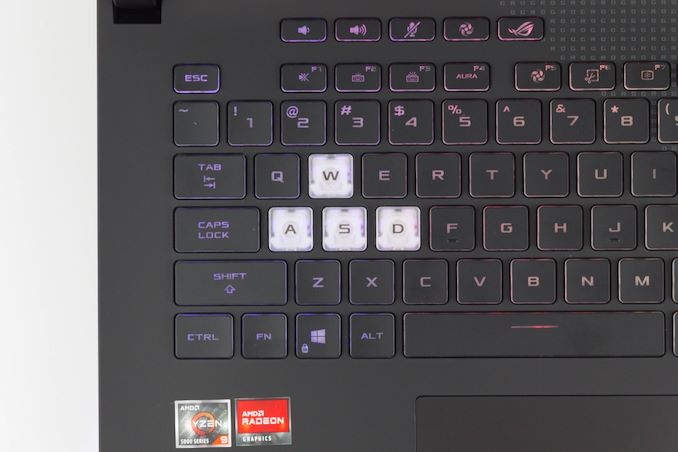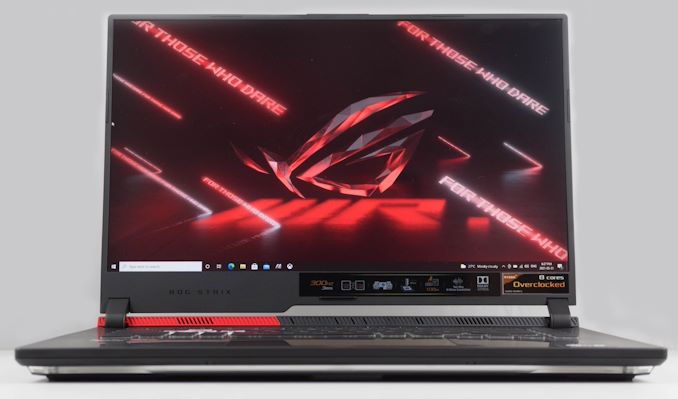The ASUS ROG Strix G15 (G513QY) Review: Embracing AMD's Advantage
by Brett Howse on May 31, 2021 11:00 PM ESTFinal Thoughts
AMD wants to introduce the world to their new AMD Advantage, where the combination of Ryzen processors and Radeon graphics offer synergies that tight integration allows, and to showcase this, they sent us the ASUS ROG Strix G513QY gaming laptop to see how it performs. In the past, AMD struggled to get design wins in premium segments such as this, but that is certainly no longer the case. While Zen on the desktop was a resounding win, in the notebook space, it took a few generations to get all of the engineering completed. With Ryzen 4000, and now Ryzen 5000 APUs, there can be no other way to say it other than “resounding success” and the combination of Zen 3 cores in Ryzen 5000, coupled with the 7 nm TSMC process makes for a potent offering.
On the graphics side, today is the day that AMD is launching RDNA 2 in the notebook space, and that is a big deal. RDNA 2 is no longer targeting the mid-range, where arguably much of the volume is, but is instead expanding the offering to also compete at the top. With new features such as AMD SmartShift which lets the system move the power budget between the CPU and GPU on demand, Smart Access Memory which allows the processor to access all of the VRAM at once, and FreeSync premium, AMD has done a fantastic job amplifying their strengths.
The ASUS ROG Strix G513QY is most definitely a worthy device to showcase this as well. It offers a premium design, excellent cooling, and a fantastic keyboard. The small size betrays the performance within, and it really is amazing to see so much performance in such a small form factor.
The keyboard deserves attention, as it is really a fantastic design. With dedicated hotkeys, and a smart keyboard layout, the design is off to a good start. The responsiveness and feel of the keys is right up there with the best notebook keyboards in this category. ASUS uses Overstroke technology to register the key press earlier in the stroke, and it really does work. The only thing missing is per-key RGB, although the G513QY does have four zone RGB as a consolation prize.
No device is perfect, of course, and there are a couple of areas that really need improvement on the Strix G513QY. The first, and most unfortunate, is the finish. The matte black looks amazing but is so susceptible to fingerprints that it really gets dirty quickly. The smooth texture feels great but is really difficult to maintain. The second strange decision was to not include a webcam. ASUS is certainly not the only manufacturer to do this on a gaming system, but in 2021, where video conferencing is more prevalent than ever, it seems like an odd choice to exclude. It may be the price of the thin bezels on the display, however, other devices with thin bezels have managed to include a webcam. There is also, strangely, no Windows Hello support. A fingerprint reader would make a nice addition.
ASUS will be offering this G513QY in either a 1920x1080 300 Hz display, or a 2560x1440 165 Hz display panel. The review unit shipped with the lower resolution, and sadly, because of that, it is difficult to really capture the full performance of this system. The Radeon RX 6800M is so powerful, that it is basically CPU bound almost all of the time at 1920x1080. For tournament players, they may want the most responsiveness and lowest latency, so they would make that sacrifice, but for most people, the QHD panel is almost certainly going to be the better choice. Running a few games at UHD resolution on an external display showed just how capable this notebook graphics card is, since it was able to average at or near 60 FPS even at maximum settings in the games.
Cezanne in its 45-Watt guise is a treat. With eight cores and sixteen threads, the Ryzen 9 5900HX APU is very impressive. While in single-core, it trails Intel’s Willow Cove slightly, in multithreaded workloads it really shines, thanks to the efficiency of the cores.
Speaking of efficiency, the battery life on this notebook is simply amazing. Gaming notebooks have always traditionally suffered in the battery life department, but AMD’s work to almost completely power gate the GPU means that having the extra performance of the RDNA 2 GPU no longer incurs that penalty. The battery life of this notebook matched many smaller notebooks with no dGPU at all, and while part of that is from the large 90 Wh battery, the overall platform efficiency was also very strong.
The ASUS Strix G513QY also allows for seamless switching from the iGPU to the dGPU without the loss of FreeSync, and the USB-C displayport output is driven purely by the dGPU, which is very interesting indeed.
There is a lot to like here. The ASUS design is well thought out and can be customized by the end user with not only lighting, but also accent pieces which are swappable. AMD has showcased that they are finally serious about notebook performance, with not only Ryzen 5000, but now RDNA 2 graphics. Their wireless needs some work, but the impressive performance and battery life make a lasting impression. AMD wants to put its best foot forward, and they certainly have. ASUS has built a worthy system to showcase the AMD Advantage.














146 Comments
View All Comments
eva02langley - Tuesday, June 1, 2021 - link
Not interested into anything not 1440p, IPS, 144Hz, top color accuracy and Freesync... AMD promised that on stage yesterday... WTH does Asus smoke...!!!???eva02langley - Tuesday, June 1, 2021 - link
Even you guys admit that ASUS SCREWED up not going 1440p. How awesome... ASUS was already on my blacklist for the disaster the G73JH-A1 was... but this is just ridiculous, they are joke as system implementer. They proved it by their incompetence."AMD targets the Radeon RX 6800M at 2560x1440, and for good reason. As we have seen, in pretty much every title, it is completely CPU bound at 1920x1080, even with the newest Ryzen 9 5900HX as the processor. The synthetic tests, as well as the UHD resolution results, really prove this point.
Although there is certainly a market where the 1920x1080 resolution is desired for the lowest latency, in this system, that panel is really too low of a resolution for such a powerful GPU, and it becomes wasted money spent."
eva02langley - Tuesday, June 1, 2021 - link
Well, i just realized that there is a 1440p panel also... however this 1080p version should not even exist. A 1440p panel resolution can be scaled to 1080p if required... so what is the point? 300Hz??? In optimal gaming scenario at 300Hz constant, you gain 4ms of response.As a comparative, 4ms is the equivalent of ONE FPS.... from 250Hz-251Hz... only idiots will defend this stupidity.
eva02langley - Tuesday, June 1, 2021 - link
Ah, I made a mistake in the calculation. The difference is more in the realm of 50 FPS at a 120Hz basis. So basically, 120Hz to 170Hz is the same amount of time from 144Hz to 300Hz.Makes more sense. But still, 50Hz from 120Hz is worth the same than 144Hz to 300Hz. Meaning those 50Hz are worth those 156Hz. This is because FPS are not a linear factor and a ratio.
Spazosaurus - Tuesday, June 1, 2021 - link
Perhaps the next generation of gpus will have enough power to render even the most demanding titles at 2k60 baseline, at which point I'll happily embrace 2k laptop displays. Native 1080p,to me, looks much better than 1080p on a 2k display. Personally I prefer a lower res native display so that I can crank up the quality settings. Once I'm over 60fps, it does not matter if I'm cpu bound or not. I'm not going to lower a native 2k display to 1080p to get 60fps.Spunjji - Friday, June 4, 2021 - link
This GPU isn't going to have any problems rendering any modern titles in 1440p at more than 60fps - at least, not unless you use RT...DanaGoyette - Tuesday, June 1, 2021 - link
I initially thought: ooh, real home, pageup, pagedown, and end keys... But nope, the right column is media playback control keys, and those text cursor control keys are hidden behind Fn.I guess I'm sticking with my HP Omen.
Pacinamac - Tuesday, June 1, 2021 - link
Competition is the best thing for the consumer. Doubt I'll get an AMD system (I'm a video editor who uses quicksync) but happy to see them doing so well.jenesuispasbavard - Tuesday, June 1, 2021 - link
I'm confused with these GPU tests. Comparisons to the competition at only 1080p? Only this laptop's performance at 4K (no comparisons)? 3DMark Fire Strike - which is *eight* years old now; and no Time Spy or Port Royal? 3DMark total score and not GPU score?ksec - Tuesday, June 1, 2021 - link
Why did they not call it Amdvantage is beyond me.